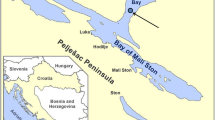Abstract
Scallop spat produced for continued culture normally requiretransportation between sites, and the associated stresses may causemortalities. In the present experiment, scallops of 40–55 mm shell heightwere emersed in air for time intervals up to 24 h and their behaviourexamined once re-immersed. Scallops were placed upside-down and thenumber of movements and the cumulative numbers righting in 5 min timeblocks were recorded. The greatest frequency for all behaviouralresponses was found at 15–17 °C in August. Responses were reducedin November and June (9–11 °C) and least at 5 °C in January.All effects of treatment, temperatures and season, and increases in airexposure were significantly different. Following the treatments, mortalitiesafter 10 days in culture was about 10–30% for scallops emersed for 18 and24 h in August and June. Scallops did not show significantly differentbehaviour whether they were emersed upright or inverted. However,scallops emersed at 15 °C had fewer responses than scallops held at <10 °C, so chilling during transport may prolong scallop vitality. Theresults suggest that air exposure >12 h should be avoided. At temperatures>9 °C, behavioural responses may be a simple and effective method toassess vitality which can assist in the management of scallop culture.
Similar content being viewed by others
References
Barbeau, M.A., Scheibling, R.E., Hatcher, B.G., Taylor, L.H. and Hennigart, A.W. (1994) Survival analysis of tethered juvenile sea scallops Placopecten magellanicus in field experiments: effects of predators, scallop size and density, site and season. Marine Ecology Progress Series 115, 243–256.
Boadas, M.A., Nusetti, O., Mundarain, F., Lodeiros, C. and Guderley, H. (1997) Seasonal variation in the properties of muscle mitochondria from the tropical scallop Euvola (Pecten) ziczac. Marine Biology 128, 247–255.
Comely, C.A. (1974) Seasonal variations in the flesh weights and biochemical content of the scallop Pecten maximus L. in the Clyde sea area. Journal of the International Council for the Exploration of the Sea 35, 281–285.
Dredge, M.C.L. (1997) Survival of saucer scallop. Amusium japonicum balloti, as a function of exposure time. Journal of Shellfish Research 16, 63–66.
Duncan, P., Spicer, J.I., Taylor, A.C. and Davies, P.S. (1994) Acid-base disturbances accompanying emersion in the scallop Pecten maximus (L.). Journal of Experimental Marine Biology and Ecology 182, 15–25.
Epp, J., Bricelj, V.M. and Malouf, R.E. (1988) Seasonal partitioning and utilisation of energy reserves in two age classes of the bay scallop Argopecten irradians (Lamarck). Journal of Experimental Marine Biology and Ecology 121, 113–136.
Fleury, P-G., Mingant, C. and Castillo, A. (1996) A preliminary study of the behaviour and vitality of reseeded juvenile great scallop, of three sizes in three seasons. Aquaculture International 4, 325–337.
Gäde, G., Weeda, E. and Gabbot, P.A. (1980) Changes in the level of octopine during the escape response of the scallop, Pecten maximus. Journal of Comparative Physiology 124, 121–127.
Grieshaber, M. and Gäde, G. (1977) Energy supply and the formation of octopine in the adductor muscle of the scallop, Pecten jacobaeus (Lamarck). Comparative Biochemistry and Physiology 58(b), 249–252.
Kawashima, K. and Yamanaka, H. (1992) Effects of storage temperatures on the postmortem biochemical changes in scallop adductor muscle. Nippon Suisan Gakkaishi 58, 2175–2180.
Kleinman, S., Hatcher, B.G. and Scheibling R.E. (1996) Growth and content of energy reserves in juvenile sea scallops, Placopecten magellanicus, as a function of swimming frequency and water temperature in the laboratory. Marine Biology 124, 629–635.
Maguire, J.A., Cashmore, D. and Burnell, G.M. (1999) The effect of transportation on the juvenile scallop Pecten maximus L. Aquaculture Research 30, 325–333.
Manuel, J.L. and Dadswell, M.J. (1991) Swimming behavior of juvenile giant scallop, Placopecten magellanicus, in relation to size and temperature. Canadian Journal of Zoology 69, 2250–2254.
Minchin, D. (1991) Decapod predation and the sowing of the scallop Pecten maximus (Linnaeus 1758). In: An International Compendium of Scallop Biology and Culture. World Aquaculture Workshops, No 1 (eds. S.E. Shumway and P.A. Sandifer), Baton Rouge, pp. 191–197.
Ventilla, R.F. (1982) The scallop industry in Japan. Advances in Marine Biology 20, 309–382.
Zwaan, A. de, Thompson, R.J. and Linvingstone, D.R. (1980) Physiological and biochemical aspects of the valve snap and valve closure responses in the giant scallop Placopecten magellanicus II. Biochemestry. Journal of Comparative Physiology 137, 105–114.
Author information
Authors and Affiliations
Rights and permissions
About this article
Cite this article
Minchin, D., Haugum, G., Skjæggestad, H. et al. Effect of air exposure on scallop behaviour, and the implications for subsequent survival in culture. Aquaculture International 8, 169–182 (2000). https://doi.org/10.1023/A:1009246530438
Issue Date:
DOI: https://doi.org/10.1023/A:1009246530438




